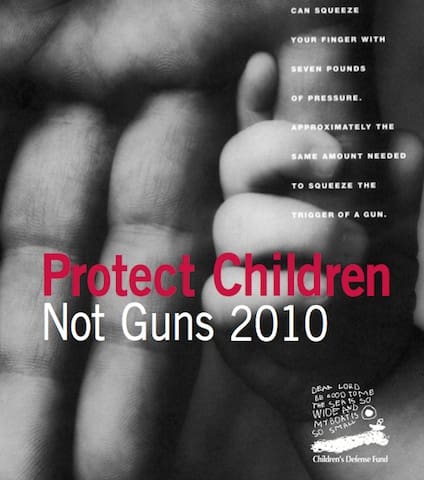“After almost two decades of reporting on youth gun violence, [the Children Defense Fund’s] latest installment of Protect Children Not Guns 2010 makes clear that our national obsession with guns continues to result in the senseless and unnecessary loss of young lives. The Centers for Disease Control and Prevention (CDC) reports that a total of 3,042 children and teens died by gunfire in 2007—a number nearly equal to the total number of U.S. combat deaths in Iraq and four times the number of American combat fatalities in Afghanistan to date. Another 17,523 children and teens suffered non-fatal gun injuries in 2007 and the emotional aftermath that follows. In each case it was a gun that ended or changed a young life forever.” Whoa. Hold on there. And teens?
Most American gun crimes are gang-related. As you might imagine, teenagers in urban areas are particularly prone to gang violence. Combining teenage gunfire-related deaths with children’s begs the question: is a 17-year-old gang banger’s death from a drive-by the same as the death of a six-year-old from a negligent discharge? As far as the CDF is concerned, yes. As far as their stats are concerned, yes again.
To their credit, the CDF’s first group of stats breaks down America’s 2007 gun fatalities into three types: homicide, suicide and accidental/unknown. Exactly 683 of those 3,042 children and teens who died from gunfire died by their own hand.
Presumably (and I know this is the subject of debate), those children would have killed themselves in some other way if guns hadn’t been available. If you pull suicides out of the equation, that leaves you with 2359 deaths, an unspecified number of which are gang-related.
Given the CDF’s focus on the prevention of firearms accidents though legal restrictions, you can understand their decision to keep accidental firearms deaths in the mix. But it should be noted that 198 children died from the negligent discharge of a firearm (or “unidentified”) in 2007. According to the CDC, 688 children drowned in the same year.
The number of 2007 gun homicides: 2161. An unspecified number of which are gang related.
The CDF’s subsequent arguments, statistics and analysis makes no distinction between children and teens; homicides and suicides and accidents. The “report” constantly conflates children with teens, and lumps all gun deaths together. Which inflates the overall figures for “gun violence” and creates an entirely mistaken impression that Americans are slaughtering their children by the thousands.
The CDF asserts that “sensible” gun control laws are the answer. States that have “sensible” gun laws have lower rates of death by gunfire. Except for Washington, DC. The nation’s capitol clocked in with America’s highest firearms-related childhood death rate: 23.7 per 100,000 children and teens. That’s seven times higher than the next most deadly state, New Mexico.
Note: during 2007, Washington, DC residents were banned from owning handguns.
The CDF report goes on and on and on. If you’re looking for all your gun control bullet points in one chart-packed document, here it is. If you’re looking for ground-breaking research or new ideas for curbing gang violence, forget it.
At the end of her Huffington Post piece announcing the “study,” CDF Prez Marian Wright Edelman asks “What is it going to take for adults in America to stand up and say enough to the violence that is terrorizing and killing our children?”
Answer: destroy the argument that says yes, children and teens die from gunfire, but we need firearms to protect our children. And to protect the freedom that we want our children to enjoy.
That’s where gun control advocates need to focus their fire: on the deeply held belief that we need guns. Only they can’t win that argument, and they know it. Not because American gun owners are pig-ignorant rednecks who cling to their guns and their religion, despite the carnage around them.
Again, American gun owners turn their back on gun control because they consider their right to bear arms vital to their personal safety and security, and the preservation of liberty.
“No enemy without poses as great a threat as the gun enemy within,” Edelman concludes.
If only that were true. And as long as the CDF thinks that way, theirs is a lost cause.





Ah, but a lost cause can still be a lucrative source of fund raising.
And the CDF is unlikely to be a victim of its own success like the NRA, that once-feared lobbying organization that is currently residing in "What-have-they-done-for-me-lately" ville.
Comments are closed.